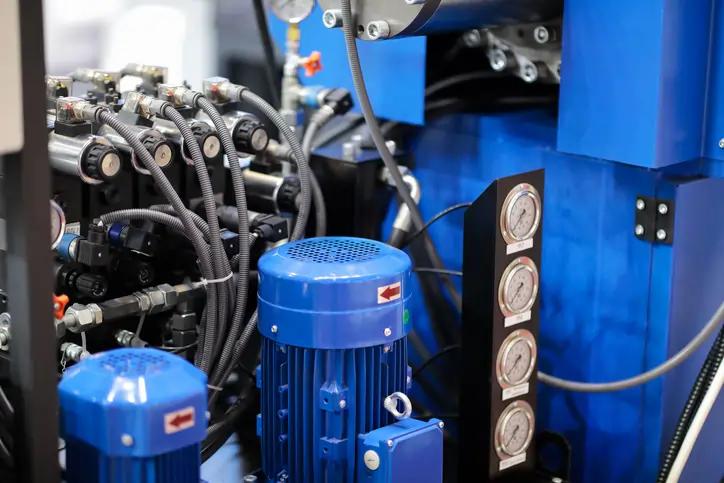Automatic Lubrication System Market to Reach $1,618.5 Million by 2034, Growing at a 4.4% CAGR
Automatic Lubrication System Market to Reach $1,618.5 Million by 2034, Growing at a 4.4% CAGR
Published by Jessica Weisman-Pitts
Posted on March 10, 2025

Published by Jessica Weisman-Pitts
Posted on March 10, 2025

The global automatic lubrication system market is projected to reach US$ 1,052.2 million in 2024. With a compound annual growth rate (CAGR) of 4.4%, the market is expected to experience steady expansion, culminating in a valuation of US$ 1,618.5 million by 2034.
This growth trajectory is driven by increasing industrial automation, rising adoption of machinery across production facilities, and the significant operational advantages offered by automatic lubrication systems.
Key Growth Factors in the Automatic Lubrication System Market
The automatic lubrication system market is expanding primarily due to increasing awareness of its benefits. Manufacturing industries are steadily shifting from manual lubrication methods to more efficient automated solutions.
The transition to automatic lubrication enhances time efficiency and improves worker safety, driving market growth. Additionally, rising labor costs act as a catalyst, further accelerating the adoption of these systems.
Centralized lubrication systems contribute to energy efficiency by reducing friction, which aligns with the growing demand for fuel optimization in vehicles. This factor further boosts market expansion.
Furthermore, the emphasis on worker safety is a major driver behind the rising adoption of automated lubrication systems. By minimizing human intervention in hazardous environments, industries can significantly reduce safety risks associated with manual lubrication processes.
For More Insights into the Market, Request a Sample of this Report: https://www.factmr.com/connectus/sample?flag=S&rep_id=9685
Key Dynamics Driving Global Automatic Lubrication System Market Growth
“Industry 4.0 Fuels Demand for Automatic Lubrication Systems”
The rising need for enhanced machinery efficiency is a key driver behind the expansion of the automatic lubrication system market. As Industry 4.0 advances, manufacturing processes are increasingly designed for automation and efficiency. In line with this trend, industries are shifting away from manual lubrication methods in favor of automated systems. These solutions help reduce friction, minimize wear and tear, and extend the lifespan of critical equipment. Sectors such as steel, mining, paper production, agriculture, food & beverage, packaging, and both on-road and off-road mobile vehicles are actively adopting automatic lubrication systems to improve operational efficiency.
“Efficiency and Automation Drive Market Growth”
The automatic lubrication system market is set for steady growth, driven by heightened awareness of maintenance efficiency and the growing demand for automation across industries. The integration of advanced technologies, including smart sensors and real-time monitoring, enhances the appeal of these systems. With the ability to provide data-driven insights and optimize lubrication processes, industries are rapidly adopting these systems to ensure consistent equipment performance. The transition from manual to automatic lubrication continues to be a crucial factor propelling market expansion.
“Predictive Maintenance Accelerates Adoption”
The increasing adoption of predictive maintenance strategies in industrial settings is another major factor fueling market growth. With automation on the rise, complex machinery is being deployed more extensively across industries, increasing the need for reliable maintenance solutions. Automatic lubrication systems reduce the risk of mechanical failure and workplace accidents by up to 90%, making them an essential tool for maintaining industrial equipment. By ensuring timely and precise lubrication, these systems support predictive maintenance strategies, reducing unexpected downtime and enhancing operational efficiency.
“Centralized Lubrication and IoT Integration Shape Market Trends”
A significant market trend is the growing preference for centralized automatic lubrication systems, which enable efficient lubricant distribution across multiple points. Additionally, the integration of the Internet of Things (IoT) is revolutionizing the industry, allowing for remote monitoring, predictive maintenance, and real-time data analysis. Customization is also becoming a key focus, with manufacturers developing tailored solutions to meet the specific needs of various industries. As these technological advancements continue to evolve, they are expected to drive further innovation and adoption of automatic lubrication systems.
Key Companies Profiled
Competitive Landscape
To strengthen their market position, these companies are adopting various strategic initiatives. Some focus on technological advancements to enhance system efficiency and reliability, while others emphasize customer-centric approaches, offering tailored solutions to meet the unique needs of different industries.
Strategic partnerships and product innovation are emerging as key growth strategies among market players. These collaborations enable companies to leverage combined expertise, foster innovation, and deliver comprehensive solutions that align with evolving industry demands.
Recent Developments
May 2023 – Graco introduced the GCI Series Cartridge Injector, the first automated lubrication injector technology in the market. This innovation aims to reduce unexpected maintenance costs and labor expenses while doubling the productivity of existing injector systems.
October 2023 – NTN Europe launched the DRIVE BOOSTER single-point automated lubricator, which can be easily integrated without modification to existing installations. This system allows customized lubrication, supports remote installation for worker safety, and offers up to 25% cost savings by automating the lubrication process.
Country-wise Insights
The automatic lubrication system market is expected to witness promising growth across various regions, with East Asia leading the way. The market in East Asia is projected to grow at a healthy CAGR of 4.7% through 2034, driven by rapid technological advancements, particularly in South Korea, Japan, and China. The adoption of sophisticated lubrication systems integrated with sensors, IoT capabilities, and smart technologies is a key factor fueling this growth. Among these countries, China is set to dominate the regional market, accounting for a substantial 57.5% share in 2024.
Meanwhile, North America’s automatic lubrication system market is also poised for significant expansion, with an anticipated CAGR of 4.1% until 2034. The region’s industrial landscape, particularly in the United States and Canada, is highly diversified, creating a strong demand for automatic lubrication systems to enhance machinery efficiency and maintenance. The increasing adoption of these systems across manufacturing, construction, and other industrial sectors is driving market growth. In 2024, the United States is expected to emerge as a key player, capturing an estimated 68.6% share of the regional market.
Get Customization on this Report for Specific Research Solutions: https://www.factmr.com/connectus/sample?flag=S&rep_id=9685
Segmentation of Automatic Lubrication System Market Analysis
The automatic lubrication system market is segmented based on system type, lubrication type, and region. In terms of system type, the market includes oil and air lubrication systems, circulating oil lubrication systems, series progressive lubrication systems, single-line lubrication systems, dual-line lubrication systems, and multi-line lubrication systems. Based on lubrication type, the market is categorized into oil-based lubrication and grease-based lubrication. Geographically, the market is divided into several key regions, including North America, Latin America, East Asia, South Asia and the Pacific, Western Europe, Eastern Europe, and the Middle East and Africa.
Check out More Related Studies Published by Fact.MR Research:
Graphite Lubricant Market: Estimated at US$ 1.76 billion in 2024, projected to reach US$ 2.69 billion by 2034, growing at a 4.3% CAGR.
Lubricant Antioxidant Market: Valued at US$ 1.92 billion in 2023, expected to expand at a 3.7% CAGR, reaching US$ 2.76 billion by 2033.
Lubricant Ester Market: Estimated at US$ 1.3 billion in 2023, forecasted to hit US$ 1.9 billion by 2033 at a 4.3% CAGR.
Hydro Lubricant Market: Projected to grow at a 9.2% CAGR, increasing from US$ 1.35 billion in 2024 to US$ 3.26 billion by 2034.
Forging Lubricants Market: Reached US$ 5.8 billion in 2021, with demand forecasted to rise at a 3.7% CAGR, hitting US$ 8.7 billion by 2032.
Explore more articles in the Research Reports category











